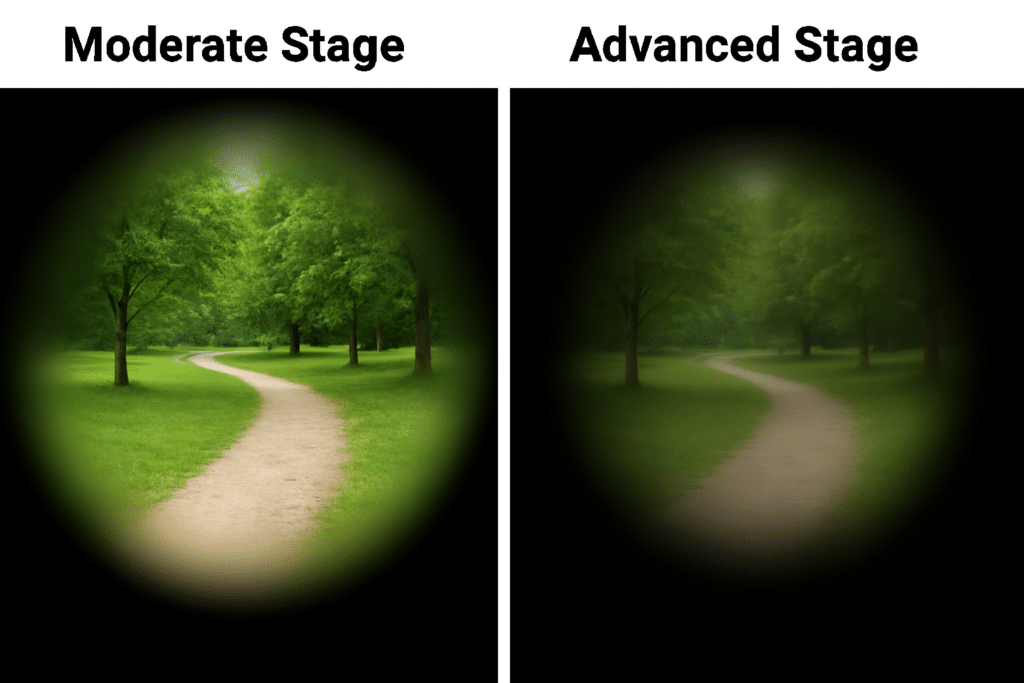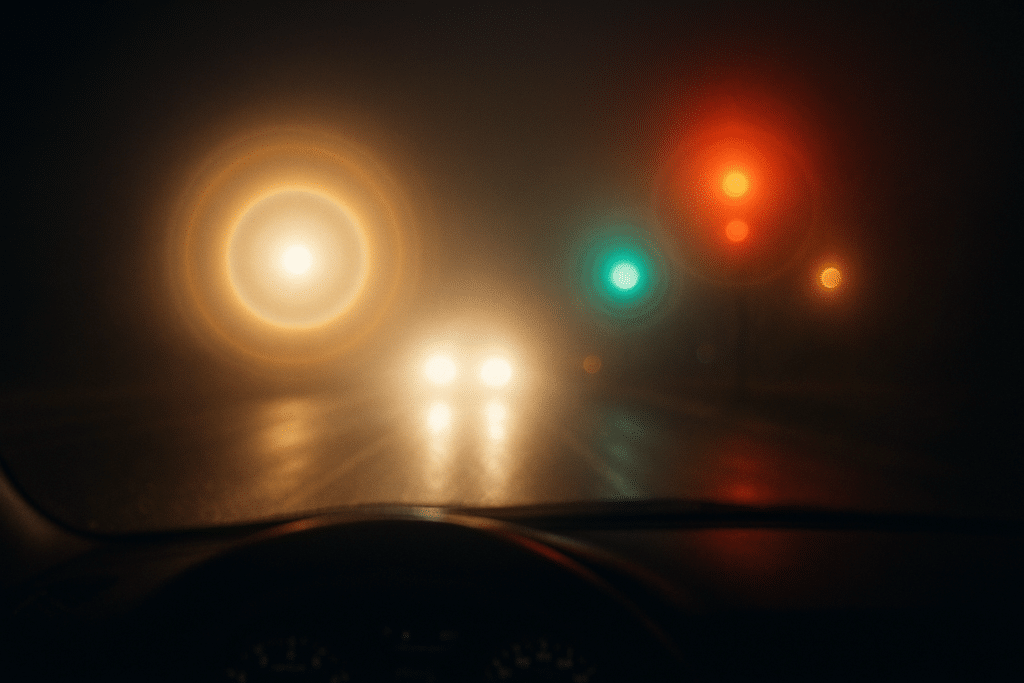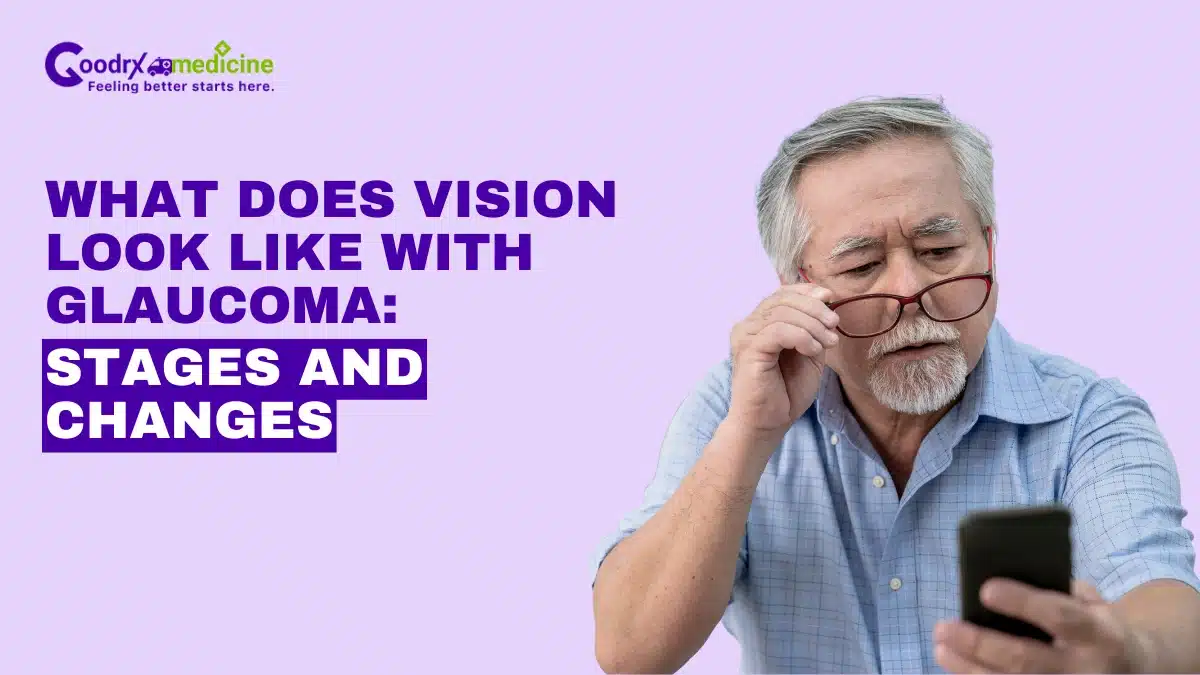Your eyesight is a precious part of your daily life. You use it to read, drive, and enjoy moments with your family. But conditions like Glaucoma can slowly change the way you see. The challenge is that these changes often begin without warning.
Glaucoma is one of the leading causes of vision loss in the United States. Many people may not know they have it until the condition advances.
This article explains what vision looks like when you live with Glaucoma. You will learn about the early changes, how vision progresses over time, and ways to manage these changes.
How Glaucoma changes vision and how it progresses
Glaucoma mainly affects the optic nerve, which sends images from your eyes to your brain. In the early stages, Glaucoma changes your vision slowly and quietly. At first, you may not notice any differences.
As Glaucoma progresses, the disease usually starts by affecting your side vision (also called peripheral vision). Over time, this vision loss can spread closer to the center, making daily activities more difficult. If left untreated, Glaucoma can eventually cause complete vision loss.
Save up to 90% on your medicine bills

Careprost 3 ml of 0.03%

Bimat 0.03% w/v

Bimaday 3 ml

Lashgrow 3 ml
Early vision changes or Glaucoma signs you might notice
Early Glaucoma may not cause pain or changes you can easily see. Most people do not feel any discomfort in the beginning.
As the disease starts, you may notice subtle problems:
- Needing more light to read or see things clearly
- Slight blurry vision, especially on the sides
- Occasional glare or trouble seeing in bright or low light
It may be harder to differentiate colors or notice things happening on the sides. These Glaucoma signs and symptoms often are so mild that you may not realize anything is wrong until you have a full eye check by a doctor.
[Visual simulation description: a photo of children playing in a park, depicting early Glaucoma; most of the image remains clear, but there might be fuzzy or faded spots at the far edges. For example:]

Moderate to advanced stages of vision loss
As Glaucoma worsens, vision changes become more obvious. The effect is usually a gradual narrowing of the field of vision. Side vision becomes more blurry or develops blank spots. This is sometimes called tunnel vision because you can see what is in front of you, but things to the side disappear.
You may also have trouble with tasks like driving or walking in crowded places. In advanced cases, central vision may start to fade.
You may notice:
- Missing objects or people to the side
- Frequent bumping into things
- Difficulty recognizing faces in a group
- Problems with bright sunlight or night lighting
[Visual Simulation: Moderate to Advanced Glaucoma
An image of a path going through a park or jungle. Only the center part looks clear for moderate, and everything else around is faded, blurry, or missing. In very late stages, the center seems dim or dark. For example,]

Other visual effects
Along with narrowing vision, Glaucoma can cause other changes. Some people experience:
- Blurry or cloudy vision
- Colors appear faded or less bright
- Reading letters that appear faded or ‘washed out’
These effects can make daily activities such as reading, phone use, or driving at night more difficult. You may feel uncomfortable in brightly lit rooms or need more light to see clearly.
[Visual simulation description: Driving at night, with bright rings around traffic lights or headlights. The lights appear with glowing halos. For example,]
What Glaucoma vision loss does not look like
The Glaucoma-related vision loss pattern is often misunderstood. Understanding what Glaucoma does not look like helps you focus on real warning signs and seek timely help.
What Glaucoma vision loss does not look like:
- Sudden complete blindness or total blackouts
- Sharp, well-defined missing chunks in vision
- Central blurry spots or dark patches early on
- Cloudy or hazy vision, like Cataracts, causes
- Uniform vision loss across the entire field right away
Recognizing what Glaucoma vision deficits are not helps differentiate it from other eye conditions and emphasizes the importance of early detection for preserving sight.
For example, comparing Glaucoma to other eye problems, Cataracts often cause cloudy vision, while Glaucoma mainly affects the edges first. In Macular Degeneration, a dark or blurry spot appears in the center; with Glaucoma, the sides usually fade first.
Management and treatment of Glaucoma
While vision loss from Glaucoma cannot be reversed, with the right steps, it can be slowed or stopped from getting worse. Early diagnosis using a Glaucoma test and treatment is essential to saving your remaining sight.
Effective ways to manage Glaucoma include:
- Regular comprehensive eye exams, especially after age 40.
- Taking prescribed medications to lower eye pressure, if recommended by your doctor.
- Following up on all eye checks, even if you feel fine.
- Considering surgical or laser solutions, as advised by your eye care professional.
Hearing about vision loss can feel overwhelming, but many people continue to live active and fulfilling lives with Glaucoma. Support from doctors, family, and caregivers makes a big difference.
Simple changes, like brighter lights at home, magnifying tools, or mobility training, can make daily tasks easier. Modern technology, like talking apps and screen readers, also helps people stay independent.
Always work closely with your eye doctor to create a Glaucoma treatment plan that fits your needs. If you have any concerns about your eyes or vision, book an appointment with an eye care professional.
Conclusion
Glaucoma slowly changes vision, beginning with damage to the optic nerve and subtle side vision loss. Early signs can be mild, like needing more light, blurry edges, or glare in bright or dim settings.
As the disease progresses, vision narrows into tunnel vision, making driving, walking, or recognizing faces harder. Other effects may also appear, such as halos, faded colors, and cloudy sight. It is equally important to note what does vision look like with Glaucoma, and what it does not. Glaucoma does not cause sudden total blindness or cloudy vision like Cataracts.
While the damage cannot be undone, timely treatment with medications, laser therapy, or surgery can protect the vision you still have. Regular eye exams, lifestyle adjustments, and support tools help you manage daily life confidently. Always consult an eye doctor to create the right plan for your needs.

Frequently Asked Questions
Can Glaucoma cause headaches?
Yes, Glaucoma can cause headaches, but only in certain types. If you have Acute Angle-closure Glaucoma, it can cause a sudden spike in eye pressure, leading to severe headaches and eye pain. Other types usually do not cause headaches. See a doctor for a bad headache or eye pain.
How to prevent Glaucoma?
To prevent Glaucoma, get regular eye exams and eat healthy foods like leafy greens and fish. Exercise and wear safety glasses to protect your eyes. Avoid smoking and manage blood pressure. Stay active and prioritize health, especially if you have a family history. Regular visits to the ophthalmologist are essential.
What does Glaucoma look like on a scan?
When you see a Glaucoma scan, it shows damage to the optic nerve. The nerve looks hollow or cupped because some nerve fibers are lost. The scan also shows parts where vision is missing. The eye pressure may look higher. This helps your doctor track the disease and treat it.
What causes Glaucoma?
Glaucoma occurs when eye fluid doesn’t drain properly, increasing pressure that can damage the optic nerve. It may run in families or arise from injuries. Early signs are often unnoticed, so regular eye exams are crucial. Untreated, it can lead to vision loss. See an eye doctor regularly for prevention.
Can Glaucoma be cured?
No, Glaucoma cannot be cured. But you can keep it from getting worse with medicine or surgery. If you catch it early, treatments can help protect your vision. Visit your ophthalmologist regularly to check your eyes and keep your sight safe.
When referencing outside resources, GoodrxMedicine always provides full citations. To learn more about the measures we use to maintain the quality of our content, please review our Content Information Policy.











